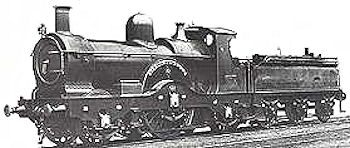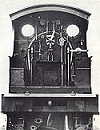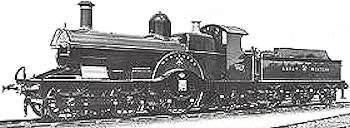
|
|
|
3001 'Dean Single' class introduction
Running numbers: 3001 - 3080.
Built 1891 (3021 - 3030) lot no. 86,
1892 (3001 - 3020) lot no. 84,
1894 (3031 - 3040) lot no. 94,
1894-95 (3041 - 3060) lot no. 95,
1897-99 (3061 - 3080) lot no. 110.
The first locomotives of this class were built between April and August 1891 as eight broad gauge convertible 2 - 2 - 2 engines, numbers 3021 to 3028 and ran in this configuration until the end of Broad Gauge working in May 1892. Another 22 locomotives were built as standard gauge 2 - 2 - 2's in late 1891 and early 1982, numbered 3029-30 and 3001 to 3020, with 3021-8 being converted to standard gauge in mid 1892.
With a driving wheel of 7 feet 8½ inches, the boiler diameter  was restricted to just 4 feet 3 inches, which required a boiler length of 11 feet 6 inches in order to provide sufficient heating surfaces for efficient steaming. With this barrel length, the engines were very heavy on the leading wheels and unsteady at speed. Unfortunately, on the 16th of September 1893, the leading axle of number 3021 Wigmore Castle broke inside Box Tunnel causing the train to derail. Between March and December 1894, all thirty members had their frames lengthened to accommodate a leading bogie altering the design to a 4 - 2 - 2 configuration. In addition the cylinder diameter was reduced from 20 to 19 inches, decreasing the tractive effort from 14,115 to 12,200 pounds. The underhung trailing springs were at first retained on the rebuilds until transfer above the platform occurred between 1895 and 1897.
was restricted to just 4 feet 3 inches, which required a boiler length of 11 feet 6 inches in order to provide sufficient heating surfaces for efficient steaming. With this barrel length, the engines were very heavy on the leading wheels and unsteady at speed. Unfortunately, on the 16th of September 1893, the leading axle of number 3021 Wigmore Castle broke inside Box Tunnel causing the train to derail. Between March and December 1894, all thirty members had their frames lengthened to accommodate a leading bogie altering the design to a 4 - 2 - 2 configuration. In addition the cylinder diameter was reduced from 20 to 19 inches, decreasing the tractive effort from 14,115 to 12,200 pounds. The underhung trailing springs were at first retained on the rebuilds until transfer above the platform occurred between 1895 and 1897.
As Wigmore Castle was being rebuilt, the first locomotive to be built new as a 4 - 2 - 2, number 3031 Achilles was also outshopped. The class were then officially known as the 3031 Achilles class, but are frequently known as the 3001 class or 'Dean Singles'. The rest of the class appeared in batches until the last, number 3080 Windsor Castle, was delivered in March 1899.
This was the period when George Churchward was experimenting with various boiler and firebox designs. The first alteration concerned the clackboxes that feed water to the boiler. A complete absence of clackboxes favoured by Dean on the initial engines was soon replaced by enormous brass mountings on the side of the barrel. In turn, these were superseded in 1898 by a much smaller mounting with a vertical feed pipe which gave way to a hidden feed to the bottom of the barrel. In the same year, in common with many classes, thicker tyres were introduced increasing the wheel diameters to 4 feet 1½ inches bogie, 7 feet 9 inches driver and 4 feet 7½ inches trailing.
Boiler Rebuilds
Churchward's main alterations to the class were in the design of the boiler, and his first modification was to number 3027 Worcester which appeared in March 1900 with a parallel Standard number 2 boiler with a drumhead smokebox, cast iron chimney and a full width cab. The barrel diameter of this boiler was 4 feet 6 inches requiring the pitch height of the boiler to be raised to  8 feet 6 inches to clear the driving wheels. For some years, 3027 was the only example of this modification until numbers 3004/13/16/18/33/39/48/52/58/67/70 and 79 were similarly rebuilt in 1905-6. Meanwhilethe Standard number 2 had developed into a tapered boiler with an outside diameter of 5 feet 0½ inches maximum, but this boiler could not be fitted without increasing the pitch height to a
ridiculous size.
8 feet 6 inches to clear the driving wheels. For some years, 3027 was the only example of this modification until numbers 3004/13/16/18/33/39/48/52/58/67/70 and 79 were similarly rebuilt in 1905-6. Meanwhilethe Standard number 2 had developed into a tapered boiler with an outside diameter of 5 feet 0½ inches maximum, but this boiler could not be fitted without increasing the pitch height to a
ridiculous size.
Meanwhile, another form of rebuilding took place affecting number 3049 Nelson. In October 1901 the engine emerged with a raised Belpaire domeless boiler and a new full width cab, a curved smokebox complete with a copper topped chimney. Similarly, number 3015 Kennet was rebuilt in September 1902. The pressure on these locomotives was raised to 180 lbs, increasing the tractive effort to 14,253 lbs., however this type of rebuild was quite short lived as Nelson's boiler was removed in August 1910, whereas Kennet's boiler was removed in June 1908 and fitted to number 3050 Royal Sovereign from 1909 to 1913.
Yet  another form of rebuild retained the round topped firebox but now with the boiler working to 180lbs pressure. This alteration was made on numbers 3041/42/43/45/55 and 62 from 1909, while later the pressure was reduced to 165 lbs. Shortly afterwards the final design of rebuilt was introduced. This involved the fitting of a raised Belpaire firebox and a drumhead smokebox onto the original barrel working at 180 lbs. The large dome was retained but a thin tall copper capped chimney with deflectors was installed. The first engine to receive this final design was number 3070 Earl of Warwick in June 1910 and it is in this condition that most people remember this pretty little engine. Between July 1910 and December 1911 another 24 engines were rebuilt to this design and they were numbers 3006/9/13/18/27/32/39/43/45/48/49/52/55/56/60/62/65/66/67/71/74 and 80. Engines rebuilt after August 1912 were also fitted with top-feed and they were numbers 3039/43/50/56/60/65/67/71 and 74.
another form of rebuild retained the round topped firebox but now with the boiler working to 180lbs pressure. This alteration was made on numbers 3041/42/43/45/55 and 62 from 1909, while later the pressure was reduced to 165 lbs. Shortly afterwards the final design of rebuilt was introduced. This involved the fitting of a raised Belpaire firebox and a drumhead smokebox onto the original barrel working at 180 lbs. The large dome was retained but a thin tall copper capped chimney with deflectors was installed. The first engine to receive this final design was number 3070 Earl of Warwick in June 1910 and it is in this condition that most people remember this pretty little engine. Between July 1910 and December 1911 another 24 engines were rebuilt to this design and they were numbers 3006/9/13/18/27/32/39/43/45/48/49/52/55/56/60/62/65/66/67/71/74 and 80. Engines rebuilt after August 1912 were also fitted with top-feed and they were numbers 3039/43/50/56/60/65/67/71 and 74.
Allocation
The class was originally built for working the West of England expresses between London and Newton Abbot via Bristol and for several years they practically monopolised this route. Unfortunately as train loads began to increase from the turn of the century and more 4 - 4 - 0 locomotives were produced, their usefulness relegated them to occasional turn of this traffic until a larger turntable was installed at Wolverhampton Stafford Road shed and the class began working to Birmingham and Wolverhampton from Paddington. In addition, other routes given over to the 4 - 2 - 2s included Worcester to Oxford and Bristol to Taunton.
Withdrawal
As just thirty members of the class had been rebuilt (some more than once!), and the difficulty in coping with more modern operating methods showed the weaknesses in the original 4 - 2 - 2 design, the first withdrawals came early in the locomotives lives. The first engines to be withdrawn were numbers 3005 Britannia and 3020 Sultan in February 1908, while the later series of rebuilt locomotives began to disappear in June 1913 with numbers 3018 Glenside and 3048 Majestic. The final 'Dean Singles' to be withdrawn were numbers 3050 Royal Sovereign and 3074 ex Princess Helena in December 1915. Contrary to popular belief, Churchward was not anxious to scrap the class but to alter the engines to a 4 - 4 - 0 configuration incorporating the 7 feet 2 inch wheels of the 'Armstrong' class, but the problems of altering the frames from a 4 feet 7 inch trailing wheel to a 7 feet 2 inch driving wheel were too great.
Specifications (later BR5 boiler).
Details: Dean Single class, 3001 to 3080 Home Page Locomotive name database Sounds of Steam Preserved Steam Locomotives Back to Basics Barry Scrapyard Sitemap Steam Locomotive Index Copyright © by John Daniel 2013.
Cylinders
(2) 19 x 24 inches
Driving wheel diameter
7 feet 9 inches
Bogie / Trailing wheel dia
4 feet 1½ in/ 4 feet 7½ in
Tractive Effort
14,253 pounds
Boiler pitch
7 feet 10 inches
Boiler pressure
180 lbs/square inch
Grate area
18.12 sq ft
Weight of locomotive
49 tons 17 cwt.
